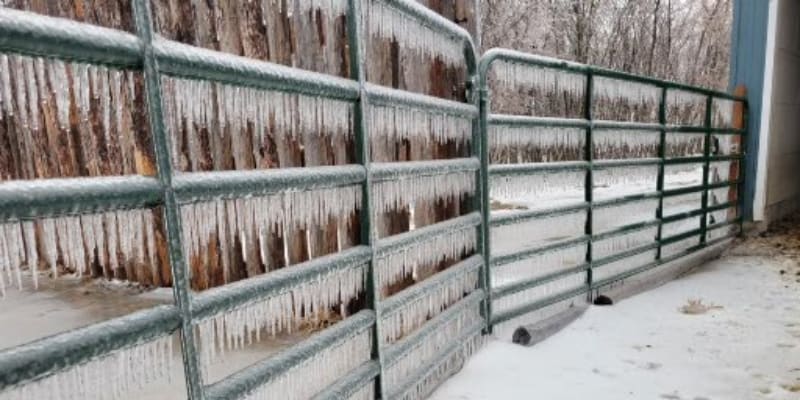Working outdoors in winter: 7 ways to do it safely

Ontario farmers understand what it means to work outdoors in all seasons, including our cold, windy, snowy winters. “Sometimes you’re in the barn, sometimes you’re out in the field, and sometimes you’re dealing with freezing water bowls at 4 am. There is always something that needs to be done, regardless of the weather,” says Ryan Dick, Health and Safety Consultant with Workplace Safety & Prevention Services (WSPS).
Watching the weather forecast and planning accordingly is something we, as Canadians, are used to doing. However, most of us think that if we dress properly in warm clothing, we will be fine working outdoors. “There’s a bit more to it than that,” cautions Ryan. “Farmers really need to understand the risks of working in cold temperatures, to know that it’s about more than just what the thermometer says, and be able to recognize the symptoms of cold stress.”
How cold impacts our bodies: Hypothermia, frostbite, and wind chill
When our bodies are exposed to cold temperatures, cold stress becomes a significant risk. Cold stress occurs when our body is unable to maintain its core temperature. When this happens, blood flow shifts from our extremities (i.e., hands and feet) to our core to increase heat production. Ongoing loss of body heat could lead to hypothermia.
Anyone working outdoors during winter should be familiar with the signs of hypothermia:
- Mild — shivering, grogginess, and confused thinking/poor judgement
- Moderate — violent shivering, slow, shallow breathing, slurred speech, and poor coordination
- Severe — loss of consciousness, little or no breathing, and weak, irregular, or no pulse
Frostbite is the most common condition from which you need to protect yourself and your workers. It occurs when exposed skin freezes, often resulting in tingling or numbness. “It can happen quickly, especially when you factor in the wind chill,” says Ryan. “It’s not enough to consider only the temperature. It may be minus 9 degrees outside, but once you add even a light wind, it could feel more like minus 15 or 20 degrees on your skin.”
Layers are critical to reduce sweating
“Layers are so important when you are working in cold temperatures because they can help reduce sweat,” explains Ryan. “Most of us sweat when we are exerting ourselves. That sweat will make your clothes and your skin wet. Then, as soon as you change tasks or stop that level of exertion, that wetness will make it even more difficult for your body to maintain its temperature in the cold,” explains Ryan.
This is why Ryan recommends dressing in multiple layers when working in cold weather, rather than wearing one very heavy coat. “As your body feels warmer or colder, you can remove a layer or put it back on,” says Ryan. “This reduces the likelihood of your clothing becoming soaked in sweat, while still protecting your skin from exposure.”
Do these 7 things when working outdoors in winter
Teach your workers how to recognize frostbite, cold stress, and hypothermia and ensure they know what steps to take if someone experiences symptoms. “Communication is very important. You should always know where workers are and have a way to communicate with them,” says Ryan. Provide training on how to safely work outdoors in the cold and include these tips.
- Dress for the weather in layers. “Even if you think you’re only going to be outside for a few minutes, wear the proper outdoor clothing for the weather,” says Ryan. “Circumstances can change quickly, so you need to be prepared.” Reduce sweating by wearing layers that can be removed.
- Avoid working alone. As much as possible, plan the work so that no one is out working alone. It’s difficult to recognize the symptoms of cold stress and hypothermia in yourself, so it’s important to have someone with you who can take action if needed. If someone is lying on the frozen ground in distress, their body temperature will drop quickly, so every minute counts.
- Wear high-visibility vests. Winter weather conditions can change drastically from one minute to the next. “Visibility can become very poor very quickly,” says Ryan. If you need to locate a worker who needs help, high-visibility vests will make them easier to find.
- Stretch and warm up your body before starting work. “Don’t forget about the impact cold temperatures have on our muscles,” reminds Ryan. “If your body is not warmed up, going straight to lifting that bag of feed in the cold could put you at higher risk for a muscle injury.”
- Monitor the weather. Avoid working in extreme weather, such as blizzards or freezing rain, when at all possible. Pay attention to the wind chill and factor it into your work plans for the day.
- Plan to do certain tasks in the warmer part of the day. Good planning will reduce your risk of cold stress and frostbite. Minimize outdoor exposure during the colder portions of the day. Instead, focus on other tasks that may allow for a warmer work environment.
- Get proper rest. Fatigue sets in more quickly when you are cold, so make sure you are well-rested. Plan to take regular breaks, if possible, and be sure to eat and drink frequently (but limit caffeine).
Check out the WSPS Agriculture Safety Centre for everything you need to keep yourself and your workers safe.
The information in this article is accurate as of its publication date.




